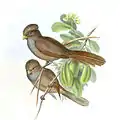Brown parrotbill
The brown parrotbill (Paradoxornis unicolor) is a parrotbill found in the central and eastern Himalayas. It is also known as the brown suthora.[2] This is a 17–19 cm (6.7–7.5 in) long grey-brown bird with a long tail and a characteristic small, yellowish, parrot-like bill. A dark stripe runs above the eyes and along the sides of the crown. The bird moves in small groups and will sometimes join mixed species foraging flocks.[3] It is found in Bhutan, China, India, Myanmar, and Nepal.
| Brown parrotbill | |
|---|---|
 | |
| Zuluk, Sikkim, India | |
| Scientific classification | |
| Domain: | Eukaryota |
| Kingdom: | Animalia |
| Phylum: | Chordata |
| Clade: | Dinosauria |
| Class: | Aves |
| Order: | Passeriformes |
| Family: | Paradoxornithidae |
| Genus: | Paradoxornis |
| Species: | P. unicolor |
| Binomial name | |
| Paradoxornis unicolor (Hodgson, 1843) | |
| Synonyms | |
|
Cholornis unicolor | |
Originally described by Brian Houghton Hodgson in the genus Hemirhynchus, this species was later moved to the genus Heteromorpha.[4] It is now usually treated as a member of the family Paradoxornithidae, where its closest relative is the three-toed parrotbill.[5] Subspecies canaster, described by Thayer and Bangs in 1912 from Hsikang, and saturatior, described by Rothschild in 1921 from Yunnan, are generally not considered valid.[6]
Gallery
 At Singalila National Park, West Bengal, India
At Singalila National Park, West Bengal, India Illustration by John Gould
Illustration by John Gould
References
- BirdLife International (2016). "Cholornis unicolor". IUCN Red List of Threatened Species. 2016: e.T22716787A94510829. doi:10.2305/IUCN.UK.2016-3.RLTS.T22716787A94510829.en. Retrieved 14 November 2021.
- Grewal, Bikram; Harvey, Bill & Pfister, Otto (2014). Photographic Guide to the Birds of India: and the Indian Subcontinent, Including Pakistan, Nepal, Bhutanh, Bangladesh, Sri Lanka & the Maldives. Hong Kong: Periplus Editions. p. 495. ISBN 9781462914852.
- Rasmussen, PC & JC Anderton (2005). Birds of South Asia. The Ripley Guide. Volume 2. Washington DC and Barcelona: Smithsonian Institution and Lynx Edicions. p. 462.
- Penhallurick J & C Robson (2009). "The generic taxonomy of parrotbills (Aves, Timaliidae)" (PDF). Forktail. 25: 137–141. Archived from the original (PDF) on 2011-06-10.
- Yeung, CKL; Rong-Chien Lina; Fumin Lei; Le Man Hung; Wei Liang; F Zhou; L Hang; S-H Lia & X Yang (June 2011). "Beyond a morphological paradox: Complicated phylogenetic relationships of the parrotbills (Paradoxornithidae, Aves)". Molecular Phylogenetics and Evolution. 61 (1): 192–202. doi:10.1016/j.ympev.2011.06.004. PMID 21704175.
- Deignan HG; RA Paynter Jr. & S D Ripley (1964). Mayr, E & Paynter, R A Jr. (eds.). Check-List of Birds of the World. Volume 10. Cambridge, Massachusetts: Museum of Comparative Zoology. p. 432.
- Robson, C. (2007). Family Paradoxornithidae (Parrotbills) pp. 292 – 321 in; del Hoyo, J., Elliott, A. & Christie, D.A. eds. Handbook of the Birds of the World, Vol. 12. Picathartes to Tits and Chickadees. Lynx Edicions, Barcelona.
